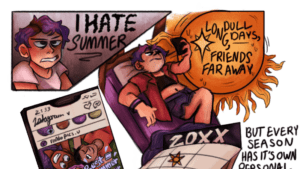
Any student at the School of the Art Institute of Chicago has a free book waiting for them, if they so choose: “Octavia’s Brood: Science Fiction Stories from Social Justice Movements,” edited by adrienne maree brown and Walidah Imarisha, is available now at The Cultural Oasis. The book is this year’s pick for the shared reading initiative, now in its fourth year.
The shared reading initiative came in 2020 as a response to wide-spread racial injustices in the United States, such as the murders of George Floyd by the Minneapolis police and Breonna Taylor by the Louisville Metro Police. These acts called into question the racial and social injustices that are prevalent in our institutions, including here at the School of the Art Institute of Chicago. In response to the efforts and pressure of student groups, the school began implementing anti-racist practices, including the creation of the Anti-Racist Committee. The committee decided one way to address the lack of diversity and inclusion in SAIC’s curriculum was to start a shared reading, a school-wide reading of a text.
In its first three years, the shared reading texts were non-fiction. They included “Caste: The Origins of Our Discontents” by Isabel Wilkerson, “The Trayvon Generation” by Elizabeth Alexander, and “Minor Feelings: An Asian American Reckoning” by Cathy Hong Park. This is the first year the shared reading is a fiction book.
“Fiction is a way for us to deal with social issues and social commentary and dream of possible ways of being,” said Sekile Nzinga, the vice president of Diversity, Equity, and Inclusion at SAIC.
While in the process of selection, Nzinga and the shared reading review committee focused on making the shared reading text accessible to as many people as possible.“Octavia’s Brood: Science Fiction Stories from Social Justice Movements,” is made up of 22 short stories,a forward, an intro, and an outro.
“Having those [short stories] allows for those of us who are living with different capacities to be able to engage with the text and not feel overwhelmed,” Nzinga said, adding that the format allows campus community members who are often stretched then to participate.
Imarisha opens “Octavia’s Brood” like this: “Whenever we try to envision a world without war, without violence, without prisons, without capitalism, we are engaging in speculative fiction. All organizing is science fiction.”
The editors of the book invited 20 individuals to create these worlds and write about them. While not all the contributors call themselves writers, they are all activists.
You might already be familiar with some of the story contributors: LaVar Burton practically raised a generation with his PBS show “Reading Rainbow.” “Button Poetry” on YouTube once featured contributor Bao Phi. The anthology also features a story written by Mumia Abu-Jamal, who writes from death row at State Correctional Institution Mahanoy.
The book is composed by diverse writers telling diverse stories. Whether you’re looking for a story about the humanity of superheroes, shapeshifting supermodels, or the complexities of generational trauma, “Octavia’s Brood” has something for everyone.
Nzinga said that the annual shared reading is an opportunity for students, staff, and faculty to reflect on the progress we’ve made as a community, while acknowledging the work that still needs to be done and mobilizing around it.
“There were people who were leading [DEI initiatives] long before my arrival,” Nzinga said. “That work is often invisibilized in institutions, and it’s really important for me to say: I see you, I appreciate you, I have a lot to learn from what you did, and I want you to know that I’m going to keep championing the efforts that you were trying to get done with the time and resources that you had.”
There are many ways to engage with the shared reading. Nzinga said she invites the SAIC community to attend the shared reading engagements and touch points throughout the year. She also suggested ways to co-create community, like starting a book club or creating art collaboratively.
“As the book’s unfolding, some of us just need that community to be accountable to each other, to just be and read, and we can decide if we want to chat about or not, but we can still be in community. We can also connect with the book and each other through our artistic practices,” Nzinga said.
The John M. Flaxman Library has partnered with the Office of DEI to create a resource guide where you can learn about the book, its editors, and its contributors. There are resources on visionary and speculative fiction, as well as radical imagination and prefigurative politics. If you don’t have a copy, they are available for free in the DEI office in room 711A in the Sharp building and the Cultural Oasis in the Sullivan building, room 1425.
In an effort to foster engagement, F Newsmagazine invites readers to write a review of a selected story and submit it to the magazine. Email [email protected] if you are interested.







